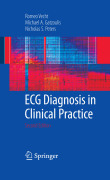
Over the last century the ECG has been used by clinicians to make major clinical decisions with regard to electric pacing, the use of thrombolytic drugs inacute myocardial infarction and the timing of surgery. In conjunction with a chest X-ray and the echocardiogram it is a fundamental part of the initial investigation of a patient with suspected heart disease. These electrical squiggles have always been difficult for students to understand. In part the problem has been that the formatting of the ECG has only become standard in the last two decades. Some important books have not provided the full twelve-lead ECG. On occasion the interpretation of the ECG has been related to complex explanations of the shapes of the electrical signals. For the practising physician muchof the interpretation is a matter of pattern recognition. Practical case-based ECG recognition handbook Portable but thorough illustrative reference INDICE: Introduction.- Basic Principles.- Ischemic heart disease.- Conduction impairment.- Rhythm disturbances.- Hypertrophy.- Cardiomyopathies and automimmune disorders.- Pericarditis, myocarditis and metabolic disorders.- Pacemakers, ICDs and cardioversion.- Pediatric ECG.- Miscellaneous cases.- Further reading.- Appendix 1: Treatment tables.
- ISBN: 978-1-84800-311-8
- Editorial: Springer
- Encuadernacion: Rústica
- Páginas: 275
- Fecha Publicación: 01/10/2008
- Nº Volúmenes: 1
- Idioma: Inglés
